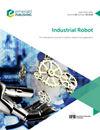Adaptive fractional-order admittance control for force tracking in highly dynamic unknown environments
IF 2.5
4区 计算机科学
Q3 ENGINEERING, INDUSTRIAL
Industrial Robot-The International Journal of Robotics Research and Application
Pub Date : 2023-02-01
DOI:10.1108/ir-09-2022-0244
引用次数: 3
Abstract
Purpose With the increasing demands of industrial applications, it is imperative for robots to accomplish good contact-interaction with dynamic environments. Hence, the purpose of this research is to propose an adaptive fractional-order admittance control scheme to realize a robot–environment contact with high accuracy, small overshoot and fast response. Design/methodology/approach Fractional calculus is introduced to reconstruct the classical admittance model in this control scheme, which can more accurately describe the complex physical relationship between position and force in the interaction process of the robot–environment. In this control scheme, the pre-PID controller and fuzzy controller are adopted to improve the system force tracking performance in highly dynamic unknown environments, and the fuzzy controller is used to improve the trajectory, transient and steady-state response by adjusting the pre-PID integration gain online. Furthermore, the stability and robustness of this control algorithm are theoretically and experimentally demonstrated. Findings The excellent force tracking performance of the proposed control algorithm is verified by constructing highly dynamic unstructured environments through simulations and experiments. In simulations and experiments, the proposed control algorithm shows satisfactory force tracking performance with the advantages of fast response speed, little overshoot and strong robustness. Practical implications The control scheme is practical and simple in the actual industrial and medical scenarios, which requires accurate force control by the robot. Originality/value A new fractional-order admittance controller is proposed and verified by experiments in this research, which achieves excellent force tracking performance in dynamic unknown environments.高动态未知环境下力跟踪的自适应分数阶导纳控制
目的随着工业应用需求的不断增加,机器人与动态环境的良好接触与交互是势在必行的。因此,本研究的目的是提出一种自适应分数阶导纳控制方案,以实现高精度、小超调和快速响应的机器人与环境的接触。设计/方法/途径在该控制方案中引入分数阶微积分重构经典导纳模型,能更准确地描述机器人-环境交互过程中位置与力的复杂物理关系。在该控制方案中,采用预pid控制器和模糊控制器来改善系统在高动态未知环境下的力跟踪性能,模糊控制器通过在线调节预pid积分增益来改善系统的轨迹响应、暂态响应和稳态响应。理论和实验验证了该控制算法的稳定性和鲁棒性。通过仿真和实验,构建了高度动态的非结构化环境,验证了所提控制算法良好的力跟踪性能。仿真和实验结果表明,该控制算法具有响应速度快、超调量小、鲁棒性强等优点,具有良好的力跟踪性能。在实际工业和医疗场景中,该控制方案实用简单,需要机器人进行精确的力控制。本文提出了一种新的分数阶导纳控制器,并通过实验验证了该控制器在动态未知环境下具有良好的力跟踪性能。
本文章由计算机程序翻译,如有差异,请以英文原文为准。
求助全文
约1分钟内获得全文
求助全文
来源期刊
CiteScore
4.50
自引率
16.70%
发文量
86
审稿时长
5.7 months
期刊介绍:
Industrial Robot publishes peer reviewed research articles, technology reviews and specially commissioned case studies. Each issue includes high quality content covering all aspects of robotic technology, and reflecting the most interesting and strategically important research and development activities from around the world.
The journal’s policy of not publishing work that has only been tested in simulation means that only the very best and most practical research articles are included. This ensures that the material that is published has real relevance and value for commercial manufacturing and research organizations. Industrial Robot''s coverage includes, but is not restricted to:
Automatic assembly
Flexible manufacturing
Programming optimisation
Simulation and offline programming
Service robots
Autonomous robots
Swarm intelligence
Humanoid robots
Prosthetics and exoskeletons
Machine intelligence
Military robots
Underwater and aerial robots
Cooperative robots
Flexible grippers and tactile sensing
Robot vision
Teleoperation
Mobile robots
Search and rescue robots
Robot welding
Collision avoidance
Robotic machining
Surgical robots
Call for Papers 2020
AI for Autonomous Unmanned Systems
Agricultural Robot
Brain-Computer Interfaces for Human-Robot Interaction
Cooperative Robots
Robots for Environmental Monitoring
Rehabilitation Robots
Wearable Robotics/Exoskeletons.

 求助内容:
求助内容: 应助结果提醒方式:
应助结果提醒方式:


